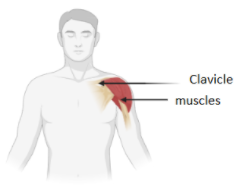
Another name for the shoulder joint is
A. Gliding joint
B. Ball and socket joint
C. Hinge joint
D. Pivot joint
Answer
547.5k+ views
Hint: The relation between bones in the body that link the skeletal system into a cohesive whole is a joint or articulation (or articular surface). They are built to allow different degrees and types of movements. Some joints are self-lubricating, almost frictionless, such as the knee, elbow, and shoulder, and are able to endure compression and sustain heavy loads while still performing smooth and precise movements.
Complete answer: Structurally known as the synovial ball and socket joint, the shoulder joint is technically known as diarthrosis and multiaxial joints. It includes articulation between the scapula glenoid cavity (shoulder blade) and the humerus head (upper arm bone). A sort of ball and socket joint is the shoulder joint/glenohumeral joint. A spheroidal joint is also known as the ball and socket joint. It is a joint in which a bone's ball-like rounded surface moves onto another bone within a cup-like depression, enabling greater freedom of movement than any other form of joint. In ball and socket joints, the maximum rotation is 360 degree. The standard space for glenohumeral is 4-5 mm. In shoulder radiographs, the normal subacromial space is 9-10 mm; this space is slightly greater in men, with a small decrease with age. In middle age, a subacromial space of less than 6 mm is pathological and may imply a supraspinatus muscle tendon rupture. The axillary area is an anatomical space between the shoulder muscles connected with it. The subscapular artery and the axillary nerve are transmitted through this vacuum.
So, option B is the correct answer.

Note: In the brachial plexus, nerves supplying the shoulder joint all emerge. They are the suprascapular nerve, the lateral pectoral nerve and the axillary nerve. Branches of the anterior and posterior circumflex humeral arteries, the suprascapular artery and the scapular circumflex artery supply the shoulder joint with blood.
Complete answer: Structurally known as the synovial ball and socket joint, the shoulder joint is technically known as diarthrosis and multiaxial joints. It includes articulation between the scapula glenoid cavity (shoulder blade) and the humerus head (upper arm bone). A sort of ball and socket joint is the shoulder joint/glenohumeral joint. A spheroidal joint is also known as the ball and socket joint. It is a joint in which a bone's ball-like rounded surface moves onto another bone within a cup-like depression, enabling greater freedom of movement than any other form of joint. In ball and socket joints, the maximum rotation is 360 degree. The standard space for glenohumeral is 4-5 mm. In shoulder radiographs, the normal subacromial space is 9-10 mm; this space is slightly greater in men, with a small decrease with age. In middle age, a subacromial space of less than 6 mm is pathological and may imply a supraspinatus muscle tendon rupture. The axillary area is an anatomical space between the shoulder muscles connected with it. The subscapular artery and the axillary nerve are transmitted through this vacuum.
So, option B is the correct answer.

Note: In the brachial plexus, nerves supplying the shoulder joint all emerge. They are the suprascapular nerve, the lateral pectoral nerve and the axillary nerve. Branches of the anterior and posterior circumflex humeral arteries, the suprascapular artery and the scapular circumflex artery supply the shoulder joint with blood.
Recently Updated Pages
Why are manures considered better than fertilizers class 11 biology CBSE

Find the coordinates of the midpoint of the line segment class 11 maths CBSE

Distinguish between static friction limiting friction class 11 physics CBSE

The Chairman of the constituent Assembly was A Jawaharlal class 11 social science CBSE

The first National Commission on Labour NCL submitted class 11 social science CBSE

Number of all subshell of n + l 7 is A 4 B 5 C 6 D class 11 chemistry CBSE

Trending doubts
Differentiate between an exothermic and an endothermic class 11 chemistry CBSE

10 examples of friction in our daily life

One Metric ton is equal to kg A 10000 B 1000 C 100 class 11 physics CBSE

Difference Between Prokaryotic Cells and Eukaryotic Cells

1 Quintal is equal to a 110 kg b 10 kg c 100kg d 1000 class 11 physics CBSE

State the laws of reflection of light




